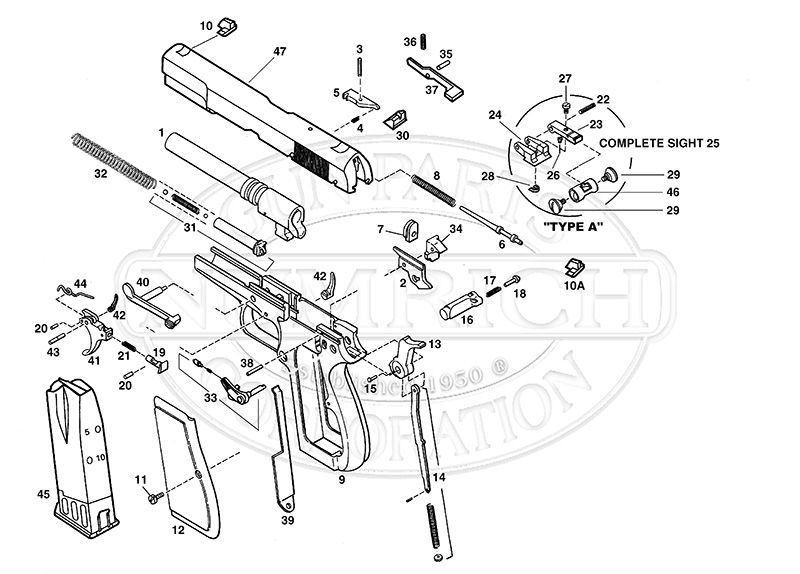The magazine disconnect, aka magazine safety, aka the magazine disconnect safety, is a device of ill repute…at least among most shooters. The device is quite controversial, but it’s nothing new.
We are going to explore the magazine disconnect, including its history, benefits, and of course, its downsides. Before we do all that, I guess we need to explain what it is. This device prevents the weapon from firing when the magazine is removed. It’s fairly simple but admittedly a controversial item. These safeties still pop up in modern guns, and for some shooters, the presence of a magazine disconnect can make or break a pistol.
History of the Magazine Disconnect
The most popular and likely most well-known magazine disconnect is the Hi-Power. The FN Hi-Power famously featured the magazine disconnect, but the device predates the 1935 pistol. A man named George H. Tansley patented a magazine disconnect in 1916. Although, the magazine safety even predates this specific patent.

Third variations of the FN Model 1905 guns had magazine disconnects and predated the 1916 patent, as does the Colt M1908 Vest Pocket. Any of the FN guns wearing the triple safety banner feature a manual safety, a grip safety, and of course, a magazine disconnect. I’m having a hard time finding the 1st gun that bore the good old mag safety.

It seemed popular on early automatic pistols. It’s worth noting prior to these pistols. The revolver was the gun of the day. The longer, heavier trigger pull of the modern double-action revolver was often considered its safety. On single-action only or striker-fired pistols, the triggers were much lighter, which seemed to scare shooters. Especially those in police and military administrations.
Additionally, the use of a detachable magazine in a pistol was somewhat new. It’s easy to see why someone with little shooting experience or experience tied only to revolvers would feel like the gun was empty when the magazine was removed.
These Days…
It’s been alive and kicking since some of the earliest semi-automatic pistols and persists to this day. Ruger is a big fan of the device, and it’s on guns like the rather new Security 9 series and the LC9. S&W used them on several 3rd-generation pistols, and until recently, of course, most Hi-Powers featured the device.
California’s Unsafe Handgun Act even name-checks the device and claims it will save many lives. That seems like a bit of an exaggeration. Interestingly enough, the magazine disconnect was seemingly only ever used in handguns. I can’t seem to find any examples of the device used in long guns.
This is likely due to the fact when these devices were invented, rifles were either single-shots or bolt-action designs. Removable magazines wouldn’t become popular for a few more decades. This spared rifles from being equipped with the devices, and they never made their way into modern rifle design.
Benefits of the Magazine Disconnect
Most of the perceived benefits of the device come down to unsafe gun handling. A magazine disconnect’s primary purpose is to allow a shooter to disable the weapon by removing the magazine. There seems to be a common thread among unsafe gun owners and shooters—the belief that removing a magazine will completely unload the weapon—and this is where the disconnect comes into play.

Admittedly, learning how to safely handle and unload a handgun is a more valuable skill. However, there have been times when it could have made a difference. The Sterling Arms company was sued out of business when an idiot removed the magazine, declared the weapon unloaded, and pulled the trigger. This paralyzed a small child.
On the flip side, Massad Ayoob stated in a 2003 issue of American Handgunner that the magazine disconnect on some S&W handguns saved the lives of police officers in a fight for their guns. They hit the magazine release button and effectively killed the gun.
Downsides of the Magazine Disconnect
There are numerous downsides to the device. The 1st is that you’ve introduced an apparatus that essentially excuses unsafe gun handling. Rather than rely on a mechanical safety, shooters should learn to clear the weapon effectively.
Speaking of, anything mechanical can fail, including the magazine disconnect. It can fail in two ways, either activated or not. If not activated, the weapon can fire, but that also means it can fire when the magazine is removed. On the flip side, if it fails and remains activated, your gun is a club now and cannot fire.

Suppose you are in the middle of a fight, and you begin to execute a tactical reload with a round-chambered. If something happens between the time you remove the magazine and attempt to reinsert the fresh magazine, you cannot fire your weapon. You are stuck with a nonfiring weapon during a vulnerable time. That runs contrary to the purpose of your firearm.
Additionally, magazine disconnects often cause extra tension on the trigger. This results in a heavier, grittier, and generally crappier trigger. Anyone who has removed the device from a Hi-Power has likely noticed an immediate improvement to their trigger.

Yay or Nay?
For me, the magazine disconnect is a big nay. I wouldn’t purchase a firearm for self-defense with it. The juice isn’t worth the squeeze. As a competent and well-trained gun owner, I know how to properly clear a handgun and obviously know that pulling the trigger isn’t the correct way to check a weapon if it’s clear.
The concept of a magazine disconnect seems to be making its way out of handgun design. Both Springfield Armory and FN released a modernized Hi-Power design, and both notably dropped the safety device. In the modern era, it’s simply not needed and not something shooters should rely on for safety purposes. Although, if you want one, Ruger has you covered.
Do you feel differently? If so, let us know below what you think.

